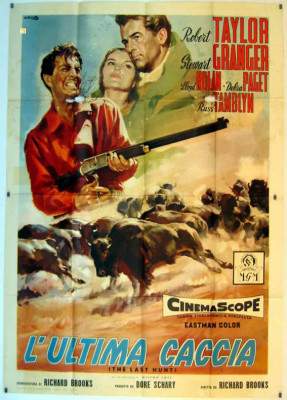| Reviews & Columns |
|
Reviews DVD TV on DVD Blu-ray 4K UHD International DVDs In Theaters Reviews by Studio Video Games Features Collector Series DVDs Easter Egg Database Interviews DVD Talk Radio Feature Articles Columns Anime Talk DVD Savant Horror DVDs The M.O.D. Squad Art House HD Talk Silent DVD
|
DVD Talk Forum |
|
|
| Resources |
|
DVD Price Search Customer Service #'s RCE Info Links |
|
Columns
|
|
|
Last Hunt, The
Economic necessity forces modest rancher Sandy McKenzie (Stewart Granger), once a celebrated buffalo hunter, back into the trade in partnership with Charlie Gibson (Robert Taylor). The partnership seems doomed from the start: McKenzie has done enough buffalo killing for one lifetime, while shooting buffalos and Indians alike is a veritable narcotic for Gibson. Indeed, slaughtering an entire standing herd of bison is virtually the only thing that seems to satiates his craving.
The pair hire two buffalo skinners: peg-legged alcoholic "Woodfoot" (Lloyd Nolan) and half-breed Jimmy (Russ Tamblyn), the latter eager to shed his Native American identity in the racist West. Gibson kills a small band of Indian raiders, taking possession of an "Indian Girl" (Debra Paget) for sex. She is attracted to McKenzie's kindness toward her but also endures Gibson's cruelty as she has nowhere else to turn.
As the buffalo population dwindles rapidly, Gibson obsesses about finding new herds to slaughter, and like Humphrey Bogart in Treasure of the Sierra Madre, he becomes crazed with paranoia when a rare white buffalo hide, sacred to the Indians, disappears, and Gibson wrongly assumes McKenzie stole it.
Grimmer even than the psychological Westerns of Anthony Mann and less romanticized than the Westerns of John Ford, The Last Hunt offers Western towns ankle-deep in mud, its citizenry openly racist toward Indians, even the women. With his shock of red hair, Billy obscures his half-breed caste status, only to have to listen to almost everyone save McKenzie and Woodfoot disparage all Native Americans as a race less than human. The emphasis on death is everywhere: valleys littered with bleached bison skeletons, and even as McKenzie exists a barbershop, another customer enters, hanging a live chicken upside-down on a coatrack, presumably payment for the man's shave and a haircut.
This reviewer was never a Robert Taylor fan, neither for his acting nor his extremist reactionary views. (He was a founding member of the far-right Motion Picture Alliance for the Preservation of American Ideals and named names before the HUAC.) His steely eyes and stern features made him better suited to playing villains or morally ambiguous heroes in Westerns. But he's excellent in The Last Hunt playing a certifiable psychopath. He goads a childhood Indian friend of Billy's into a lopsided gunfight just for the fun of killing the young man, and delights in terrorizing the never-named (a major oversight) "Indian Girl." Gibson's arrogant "white privilege" is so deeply engrained that introspection is clearly beyond his thinking. One of the interesting qualities of The Last Hunt is how the other three men respond to Gibson's heinousness: by doing nothing. No one can match Gibson's quick-draw, and his complete lack of any sense of decency gives him a decided edge whenever violence is involved.
Debra Paget had already played, most memorably, an Indian maiden in the seminal Western Broken Arrow (1950) when she was just 16. Here she plays the same character in all but name but that's forgivable: the film began shooting with Anne Bancroft in the part. After three weeks of shooting Bancroft was reportedly injured and had to be replaced, or maybe she walked off the film. Either way, it appears the picture's climax was shot first and reworked with Paget. It sure looks like Bancroft in long shots at the very end, and Paget's close shots were clearly done at the studio, giving the movie's last ten minutes a slight awkwardness absent from the rest of the movie.
Lloyd Nolan made only a couple of Westerns before this, including starring in the MGM B-film Apache Trail (1942), and was far more identified with crime thrillers and the like. He's an inspired choice for the role of Woodfoot, a philosophical drunk admired by McKenzie and who believably bonds with Billy. Stewart Granger, meanwhile, is okay as McKenzie but the actor doesn't bring all that much to the table beyond what was already in the script.
American bison once roamed the country in the millions, from as far south as Mexico and east as the Atlantic seaboard. By the end of the 19th century they were nearly extinct but gradually their numbers were brought back and, with a population of about 500,000, are no longer threatened.
Video & Audio
Filmed in early CinemaScope, The Last Hunt looks remarkably good. The folks at Warner Home Video seem to have tweaked all the color and resolution possible out of the image, and even on big screens the video transfer looks and sounds impressive, the audio adapted from the original 4-track magnetic stereo release. English subtitles are provided.
Extra Features
Supplement include two excerpts from MGM Parade, the studio's veritable ‘50s informercial series promoting its upcoming releases. One segment offers a short interview with Russ Tamblyn, but the longer segment includes much behind-the-scenes footage and interviewers with Brooks and Schary, albeit all of it obviously carefully scripted. A trailer rounds out of the extras.
Parting Thoughts
Underrated and impressively prescient, The Last Hunt is Highly Recommended.
Stuart Galbraith IV is the Kyoto-based film historian largely absent from reviewing these days while he restores a 200-year-old Japanese farmhouse.
|
| Popular Reviews |
| Sponsored Links |
|
|
| Sponsored Links |
|
|
| Release List | Reviews | Shop | Newsletter | Forum | DVD Giveaways | Blu-Ray | Advertise |
|
Copyright 2024 DVDTalk.com All Rights Reserved. Legal Info, Privacy Policy, Terms of Use,
Manage Preferences,
Your Privacy Choices | |||||||















